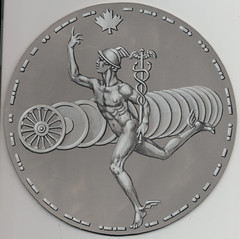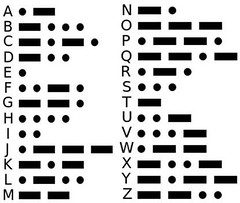
PREV ARTICLE
NEXT ARTICLE
FULL ISSUE
PREV FULL ISSUE
QUERY: MORSE CODE ON 2004 OLYMPIC COIN DESIGNJohn Regitko of Toronto submitted this question about a rejected Canadian coin design for a 2004 Olympic Games commemorative. -Editor Regarding the differences in the Morse Code/International Code variables, I wonder if Peter Jones can advise me on the following: My upcoming new book tentatively entitled "In Search of a Design" will show a number of rejected designs of themes that were selected for Canadian commemorative coins, as well as illustrations of designs of themes that were also under consideration but ultimately rejected. One of the rejected submissions was for the 2004 Olympic Games held in Athens containing what I assumed was Morse Code. However, when I start at the top of the rim to the right of the maple leaf, I get "TRANSLORTATION COMMUNICATION." The sixth letter is a L instead of a P. My draft write-up is: "The above illustration of Taylor's design includes the International Code (more commonly known as Morse Code, although there were actually three people involved in its creation and was later revised by Alfred Vail when it became known as the American Morse Code)." But in view of the last E-Sylum, I thought I better check. Please ask Peter to confirm or correct. Incidentally, if the Code on the rejected submission is indeed wrong, I am sure the product manager at the Royal Canadian Mint would have caught it. I still wonder why Raymond Taylor, a very successful Canadian coin designer, would think this is an appropriate design for a Canadian coin just because it has a small Maple Leaf at the top. Peter Jones writes: "I agree the token illustrated reads TRANSLORTATION COMMUNICATION in regular Morse code. I would rephrase John's paragraph on Morse as follows." "Samuel Morse originally intended only a sequence of numbers which the receiver of the code would look up in codebooks for their meaning as letters. "In 1840 Alfred Vail expanded the code to include letters, which became standardized in 1844 for railroad telegraphy, also called railroad Morse. Friedrich Gerke in Germany changed it in 1848, eliminating spacing within letters, allowing only dots and dashes. "Then in 1865, the International Telecommunication Union changed the code again to account for different letter frequencies, which is the Morse code we know today."
To read the earlier E-Sylum article, see:
Wayne Homren, Editor The Numismatic Bibliomania Society is a non-profit organization promoting numismatic literature. See our web site at coinbooks.org. To submit items for publication in The E-Sylum, write to the Editor at this address: whomren@gmail.com To subscribe go to: https://my.binhost.com/lists/listinfo/esylum All Rights Reserved. NBS Home Page Contact the NBS webmaster 
|


